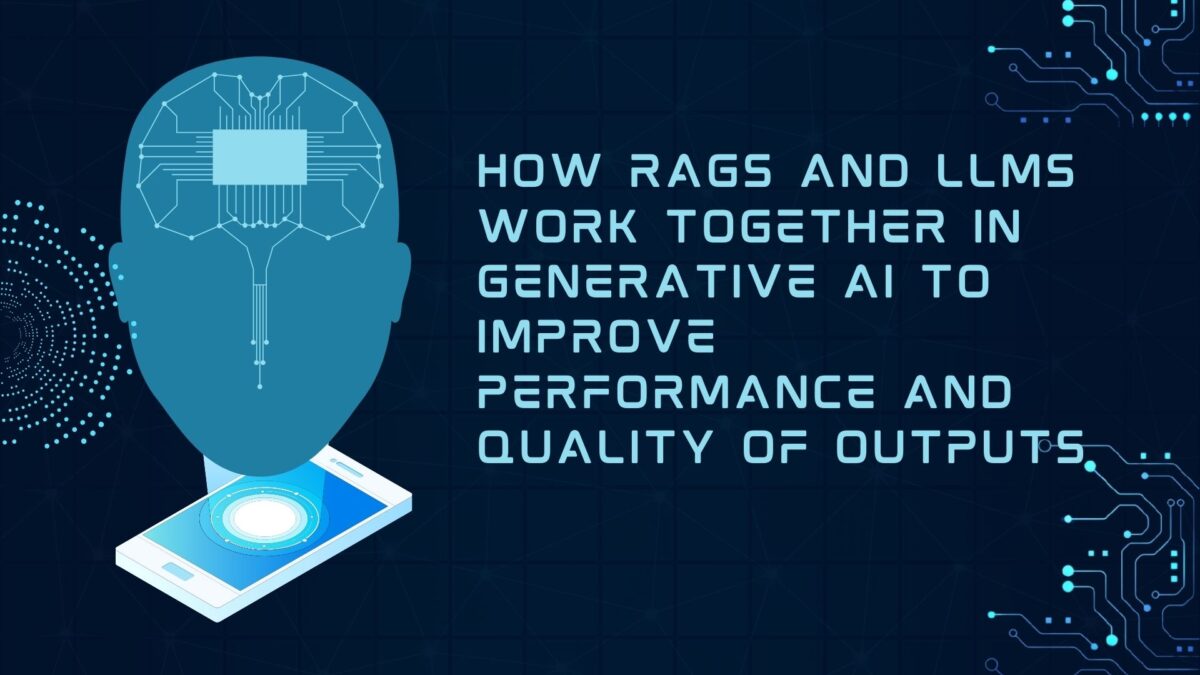How RAGs and LLMs work together in Generative AI to improve performance and quality of outputs

Introduction
 Retrieval-Augmented Generation (RAGs) and Large Language Models (LLMs). They are among the leading technologies of generative AI, as they improve the impact and the quality of outputs beyond the conception. In this blog, we will discuss the Concepts of RAGs and study their integration with LLMs for the transformation of Generative AI and make a reader resourceful about them.
Retrieval-Augmented Generation (RAGs) and Large Language Models (LLMs). They are among the leading technologies of generative AI, as they improve the impact and the quality of outputs beyond the conception. In this blog, we will discuss the Concepts of RAGs and study their integration with LLMs for the transformation of Generative AI and make a reader resourceful about them.
Understanding Generative AI

Generative AI entails systems that are in a position to generate original material, ranging from text, pictures, music among others that are ascertained to be done by humans. This technology integrates complex paradigms and structures, whose outputs can copy creativity and intelligence of individuals. The principle components that underpin Generative AI include LLMs, and RAGs.
Large Language Models (LLMs)

LLMs are novel deep neural networks designed to encode and decode natural language data based on massive corpora. Such models as GPT4 created by OpenAI have as many as billions of parameters that enable the model to adapt to and identify intricate patterns in the language. It can be observed that LLMs can carry out text completion, translation, summarization and even conversation rather competently.
Key Features of LLMs

Scale: The training of LLMs is recognized by their massive model sizes typically measured in billions of parameters. This scale allows them to understand pat- terns of language and produce text that is as high quality as is achievable.
Pre-training and Fine-tuning: First of all, LLMs go through training that can be described as two-stage. First, they are trained in the general language by feeding them a large text dataset that they will analyze. They are then adapted to specialized tasks in other to improve their performance Senna 2016 p 14.
Contextual Understanding: These models are particularly good at a deep understanding of context, which is why they are capable of providing a logically constructed and contextually adequate answer.
Retrieval-Augmented Generation (RAG)

Retrieval-Augmented Generation (RAG) is another technique that is more superior compared to LLMs because of the integration of the information retrieval technique. Whereas in a typical LLM configuration of the model, the model only utilizes its own knowledge which is very restricted by its training data. RAG deals with this by gathering the required information from the external environment in real-time, enriching the model’s knowledge.
How RAG Works
Query Formulation: Initially, the systems mention is to come up with a query based on the given prompt.
Information Retrieval: The system then searches from other auxiliary sources such as data bases or from the internet for documents or data related to the key words.
Integration: The retrieved information is incorporated into the model’s knowledge base and its response is fine tuned and more accurate.
The Relationship between RAGs and LLMs

The integration of RAGs and LLMs generates a synergistic effect, which in turn greatly improves Generative AI outputs’ performance and quality. Here’s how they work together:Here’s how they work together:
Enhanced Knowledge Base: RAGs enhance LLMs by offering twenty-first-century updated and various data on different topics in addition to the trained data of the model.
Improved Accuracy: Thus, the system can provide its responses based on the combination of the relevant data from both internal and external DBs.
Contextual Relevance: RAGs make certain that the produced outputs are timely and relevant, resulting to higher quality of work produced.
Efficiency: Thus, the use of LLMs with abilities in language generation and RAGs capable of efficient retrieval results in improved and enhanced content generation.
Use cases of RAG and LLMs in Generative AI

However, it is worth mentioning that the combination of RAGs and LLMs is changing different fields and uses. Here are some notable examples:Here are some notable examples:
Content Creation: RAGs and LLMs based Generative AI is rapidly transforming the blog writing and periodically updated articles and heat maps for marketing contents.
Customer Support: Chatbots and virtual assistant employ this technology to supply precise and contextually relevant answers to the customers’ query increasing UX.
Education: Educational tools and platforms use RAGs and LLMs for producing student-specific content and answering their queries with the latest information.
Healthcare: The application of these technologies found their place in medicine helping to create the full picture of the client’s state, to make preliminary diagnoses, and to offer suitable recommendations on the client’s health.
Case Study: Enhancing the Customer Service with RAG and LLMs

To clearly define the effects of RAGs and LLMs, there is a requirement of a concrete example in the customer support domain. This real-life application involved a well-known firm adopting the combination of RAGs and LLMs to improve the quality of response analysis in e-commerce customer support.
Problem
The major issues that the company encountered were related to the management of a large number of customers’ inquiries. The previous support system to costumers was based only on an LLM and was unable to offer the correct and recent information more often customers complained.
Solution
With help of integration of RAGs with the LLM-based support system, the company was able to search the relevant information in their product base, manuals and frequently asked questions in real time mode. This integration enabled the system to give appropriate and context-specific answers to the customer inquiries.
Results
Improved Response Quality: Thus, the system became more accurate and informative providing answers to customer’s questions.
Increased Efficiency: The integration helped and made the response time shorter on average and therefore making customers more satisfied.
Scalability: This was certainly a case in which the company was able to answer a greater number of questions without the quality of the responses suffering.
Challenges and Future Directions

While the synergy between RAGs and LLMs offers significant benefits, there are also challenges to address:While the synergy between RAGs and LLMs offers significant benefits, there are also challenges to address:
Data Privacy: Both the process of gathering and using information from other sources causes issues to do with privacy and security of data. That is why it is important to guarantee the proper handling of such data.
Bias Mitigation: It should be noted here that both LLMs and RAGs can be influenced by prejudices acquired from their training data and external information sources. The presence of these biases prevents production of neutral material; therefore, methods on how to reduce biases should be expanded.
Scalability: While it is evident that RAGs can be integrated at scale with LLMs, doing so rapidly needs proper infrastructure and proper searching methods to retain the kind of effectiveness seen in the presented methods.
Future Directions
Otherwise, the future of Generative AI is in increasing the interaction and coordination between RAGs and LLMs. Here are some potential directions:Here are some potential directions:
Advanced Retrieval Techniques: Compiling new procedures for the exacting and bringing out of comprehensible messages from a number of external sources will improve the performance of RAGs.
Personalization: The goal to make the retrieval and generation processes pertain more to the user-specified preferences coupled with the context of use will ultimately create more elaborate results to the users.
Multi-Modal Integration: Converting text-based LLMs into multimodal including textual, graphical and video based RAGs can enhance the generative AI systems.
Conclusion

The integration of Retrieval-Augmented Generation (RAG) with Large Language Models (LLMs) can be considered one of the major steps forward in the Generative AI development. Thus, using the advantages of both technologies, it is possible to reach peaks of performance and quality of the content created by AI. These technologies will only become more sophisticated with time and this will extend to different fields and even alter the way, people interface with artificial intelligence. Of course, the future of Generative AI is bright and RAGs & LLMs are bound to be central to this all futuristic advancement.
Read our Blog – Fx31 Labs partnership with Goodfirms
